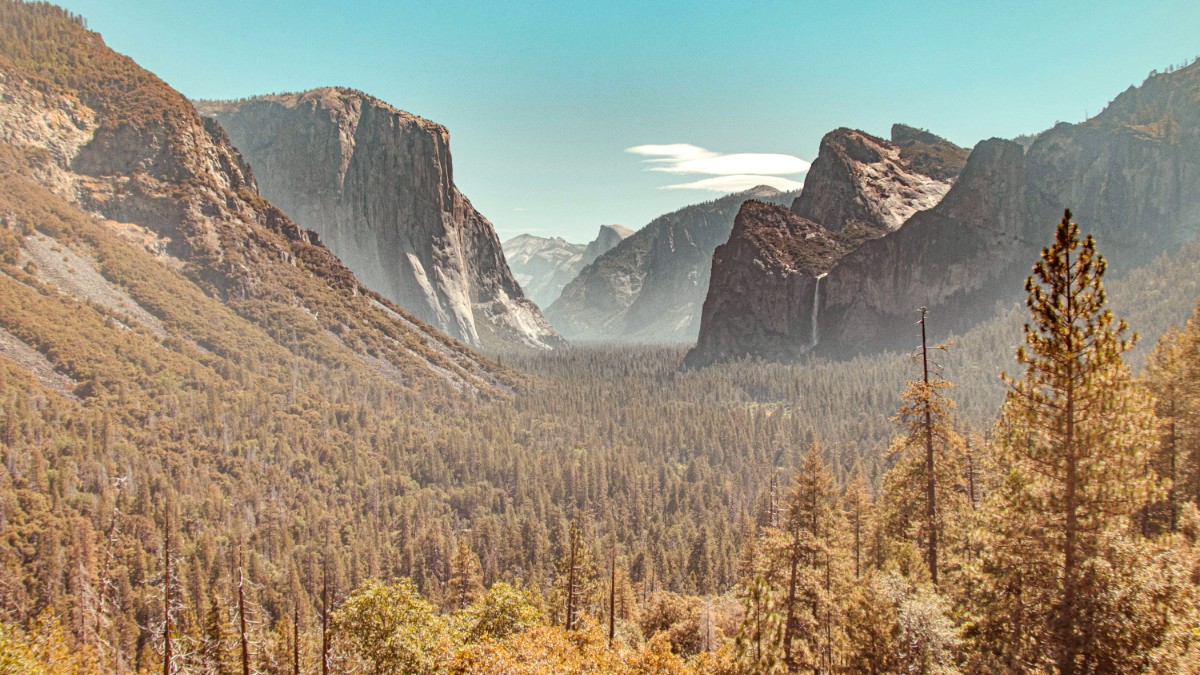
USA
Imagine standing beneath a 3,000-foot granite wall, feeling the mist of a crashing waterfall, or gazing upon trees that have stood for thousands of years. Yosemite National Park has all of these experiences and more. Located in the heart of California’s Sierra Nevada mountains, Yosemite is not just a place to visit; it is a destination that captivates and inspires. Its vast wilderness, coupled with accessible wonders, makes it a prime location for adventurers, photographers, and anyone seeking the profound beauty of nature. From the first glimpse of Yosemite Valley through the famous Tunnel View to the quiet contemplation within a grove of giants, the park delivers moments of awe.
Half Dome from Glacier Point in Yosemite National Park
Yosemite National Park is located within the central Sierra Nevada mountain range in California, approximately 160 miles (260 km) east of San Francisco and 315 miles (507 km) north of Los Angeles. This position makes it a popular destination for those traveling from California's major metropolitan areas. The park covers an expansive area of 748,436 acres (3,026.87 km²), spanning parts of Tuolumne, Mariposa, and Madera counties. This large size means the park features diverse landscapes, each with distinct characteristics and experiences.
The elevation within Yosemite varies considerably, ranging from 2,127 feet (648 m) in the western foothills to over 13,000 feet (3,962 m) at Mount Lyell, the park's highest point. Lower elevations feature oak woodlands and chaparral, transitioning to mixed conifer forests at mid-elevations. The high country, accessible only seasonally, consists of subalpine and alpine zones with scattered trees, meadows, and bare granite. Yosemite Valley, an U-shaped glacial valley, is the park's centerpiece and the destination for most visitors. It is enclosed by towering granite cliffs like El Capitan and Half Dome, which rise thousands of feet from the valley floor.
Massive rock formations carved by ancient glaciation.
Meanders through valley meadows, reflecting surrounding cliffs.
A sprawling subalpine meadow with granite domes and peaks.
Yosemite Falls, Bridalveil Fall, Nevada Fall. Peak flow during spring snowmelt.
Mariposa, Tuolumne, and Merced Groves with ancient trees.
A massive granite monolith, El Capitan is a world-class destination for rock climbers, drawing adventurers from across the globe to test their skills on its sheer faces.
Half Dome, a distinctive granite dome, serves as a symbol of Yosemite National Park. Its unique shape and challenging ascent make it an iconic feature for hikers and photographers alike.
The combination of these diverse geographical elements creates a varied and awe-inspiring environment, inviting exploration from valley floor to high peaks.
Yosemite's natural splendor found recognition early in U.S. History, leading to its protection. In 1864, during the Civil War, President Abraham Lincoln signed the Yosemite Grant. This act set aside Yosemite Valley and Mariposa Grove of Giant Sequoias for public use and preservation. This was a groundbreaking move, predating the establishment of the national park system. The Grant marked the first time the U.S. Federal government protected scenic land for public enjoyment, laying a precedent for future national parks. California was entrusted with its management.
Muir spent considerable time in Yosemite, exploring its wilderness and writing extensively about its beauty. His writings brought national attention to the park's wider area, beyond the initial grant. Muir, alongside editor Robert Underwood Johnson, campaigned for greater federal protection of the surrounding high country. This advocacy led to the establishment of Yosemite National Park in 1890, encompassing a much larger area beyond the original 1864 grant. Muir’s efforts established the philosophy of wilderness preservation that guides the national park system today. He helped shift public opinion toward protecting natural spaces for their intrinsic value, not just for recreation.
Initially, the U.S. Army managed Yosemite National Park, with cavalry troops serving as park rangers. This continued until the creation of the National Park Service (NPS) in 1916.
Park management then transferred to the NPS, a civilian agency designed to protect and preserve national parks for future generations, bringing a more consistent approach.
Yosemite's enduring value received international recognition in 1984 when designated an UNESCO World Heritage Site, recognizing its unique features.
Yosemite National Park is in the Sierra Nevada mountains, California, USA.
The park encompasses 748,436 acres (3,026.87 km²), offering diverse environments.
Yosemite became a National Park on October 1, 1890, for federal protection.
Explore the central hub with its U-shaped profile and iconic rock formations.
Venture into expansive wilderness, including Tuolumne Meadows.
Walk among hundreds of ancient giant sequoia trees in Mariposa Grove.